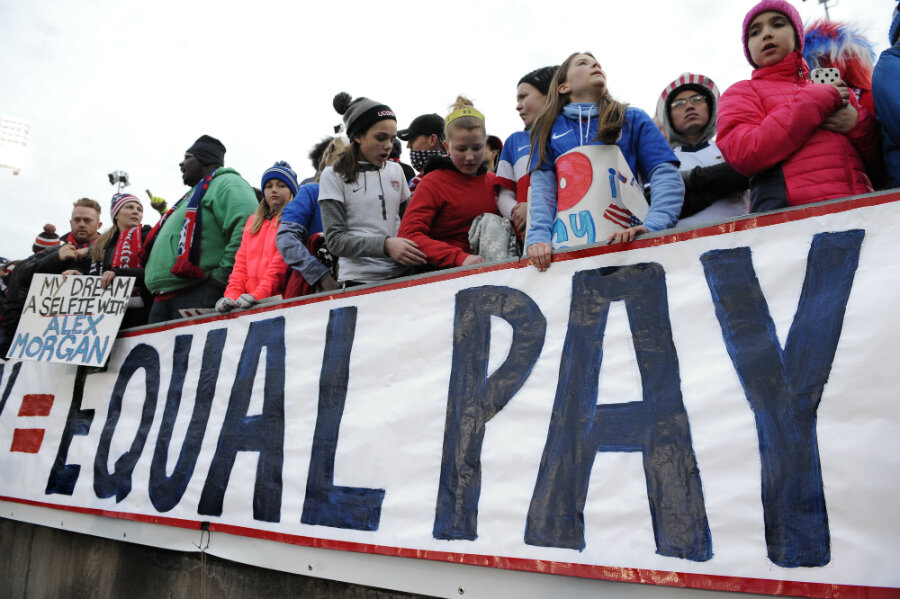Equal Pay Day is earlier this year, but how far have women really come?
How many extra hours do you women have to work to catch up to men’s paychecks?
Just over three months worth in 2016, it turns out.
Falling on Tuesday, April 4 this year, Equal Pay Day marks how far into 2017 women have to work to earn what men took home by the end of 2016, thanks to a historical gap in wages that favors men’s earnings. In 2016, the day took place on April 12, meaning women had to work nearly three-and-a-half months more to meet men’s earnings.
And while reaching that day sooner in 2017 may seem like a step forward, advocates are hesitant to call the change a sign of significant progress when a large pay disparity remains.
“Unfortunately, the gender pay gap has barely changed at all over the past year and even over the past decade,” Sarah Fleisch Fink, director of workplace policy and senior counsel at the National Partnership for Women and Families (NPWF) says, noting that the average gap has advanced from 79 cents on the dollar to 80 cents in the past year. “We’re talking about a penny difference, so that obviously is not significant. We’re not seeing a big progress; we’re not seeing the gap closing very quickly at all. That’s really what makes us continue to elevate Equal Pay Day.”
As activists continue to fight for equal pay, the day is meant to convey the wage gap’s persistence, and show how those missing pennies add up over a year. Overall, American women miss out on some $840 billion a year because of the gap, and on an individual level, that means women could be losing the funds to buy more than a year’s worth of groceries or childcare.
And not all women earn equally, either, with variances found across ethnic groups and from state to state. For instance, black women make an average of 63 cents on every dollar made by white men, while Hispanic women make an average of just 54 cents, according to the NPWF. And while states such as Delaware and New York see smaller gaps of just 11 cents, women in Wyoming and Louisiana make 36 and 32 cents less than men on every dollar, respectively, putting them at stark disadvantages when it comes to supporting themselves and their families.
Legislators and advocates have launched various efforts to close the gap in recent years. In Massachusetts and Philadelphia, officials have passed laws that bar employers from asking job applicants about their past pay rates, a move many hope can break cycles of underpayment working in which women can find themselves. Some have made it illegal to penalize employees for speaking openly about their salaries, arguing that women cannot fight discrimination if they aren’t aware it’s taking place.
But there’s still work to be done. Female legislatures were expected to reintroduce the The Paycheck Fairness Act Tuesday, which would make it easier for women to bring suits against employers who discriminate against them based on gender. The proposed act has been submitted to every session of Congress for 20 years without successfully passing.
That move comes just after President Trump moved last week to revoke the 2014 Fair Pay and Safe Workplaces order put into place by former President Barack Obama. That measure had required that companies with federal contracts comply with labor and civil rights laws that create paycheck transparency and put a ban on forced arbitration clauses for sexual harassment, sexual assault, and discrimination claims.
Eradicating the gap will require more than mere legislative efforts, experts say. While part of the pay gay comes from discriminatory patterns, another part comes from the fact that women overall still gravitate toward lower pay fields than men.
“I think we really need [legislation and societal changes] happening simultaneously,” Judith Levine, a sociology professor at Temple University in Philadelphia, previously told The Christian Science Monitor. “These legislative changes can be very powerful. But without changes in attitudes and culture, there are limits to what they can do. But of course there’s a relationship between the two; as the laws change, the attitudes change. And as the attitudes change, the laws change.”
And that’s where businesses can play a role as well. Employers can self audit their companies and examine the rules and policies put into place that determine salary, Ms. Fleisch Fink says, looking for evidence of salary discrimination they might not know exists in their own workplace.
“Marking Equal Pay Day allows people to really contextualize what we’re talking about,” she says. Women “had to put in three more months of work to make the same money men did last year. Together, the public policy solutions and the employer initiative solutions can really come together to close this gap.”






